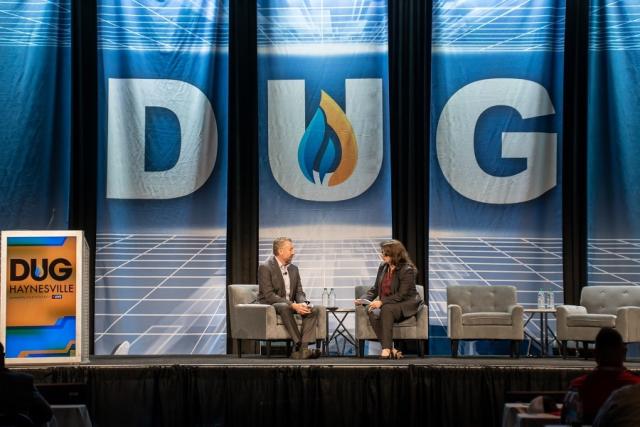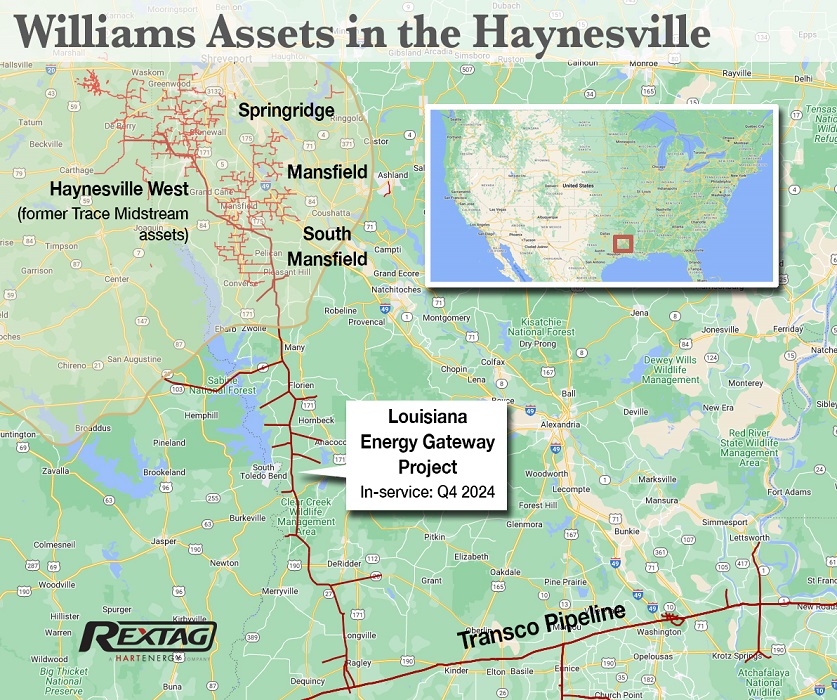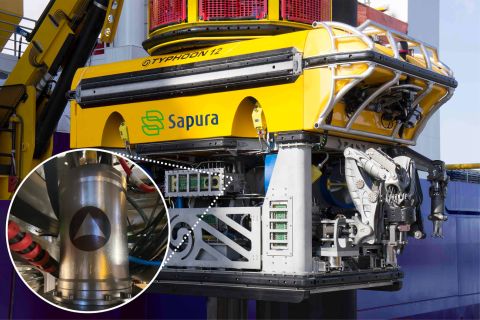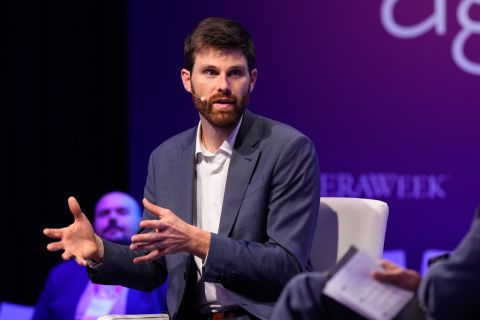
Larry Larsen, senior vice president of Williams’ gathering and processing operations, speaks with Hart Energy's Deon Daugherty, Oil and Gas Investor magazine's editor-in-chief, at the DUG Haynesville conference on March 29. (Source: Hart Energy)
SHREVEPORT, La.—The Louisiana Energy Gateway (LEG), Williams Cos.’ natural gas pipeline project that will connect the Haynesville Shale with Gulf Coast natural gas customers, will also be a conduit for the company’s decarbonization strategy.
The 1.8 billion cubic feet per day pipeline, scheduled to be in service late 2024, is a lynchpin of the company’s “wellhead-to-water” strategy to deliver gas to LNG export terminals primed to come online during that time, as well as Williams’ Transco pipeline system transporting gas to the East Coast.
LEG also presents the opportunity to develop carbon capture and storage (CCS) infrastructure and decarbonize the natural gas value chain, said Larry Larsen, senior vice president of Williams’ gathering and processing operations at the DUG Haynesville conference on March 29.
The LEG project, which received its final investment decision in June 2022, is expected to enter service at a pivotal time.
“Right in time for when you see a lot of that next wave of LNG projects coming online,” Larsen said. “And right in time when I think, hopefully, we’ll start seeing the [gas market] start to balance out, so we’re really focused on making sure we get this executed in a timely manner.”

In the grand scheme of the energy transition, Williams is carving out a grand role for itself. It includes the acquisition from Quantum Energy Partners of Trace Midstream’s assets in the Texas side of the Haynesville in March 2022. The deal also brought Quantum’s Rockcliff Energy into a long-term capacity commitment to the LEG project.
From the start of 2021 to the end of 2022, Williams’ legacy assets in the Louisiana side of the Haynesville saw a 50% growth in gathered volumes as the industry came out of the pandemic. When the Trace Midstream assets on the Texas side are added, the volume triples in that 24-month period.
Williams is also moving aggressively in monitoring and certification technology, Larsen said. It has invested in Orbital Sidekick, a company planning to launch a satellite next quarter laden with emissions monitoring equipment. Another technology partner, Context Labs, has developed a platform aggregate to analyze all the monitoring data gathered profile.
“We see this as an opportunity for us to really validate all the way across the value chain, all the way from the wellhead through our assets, and be able to demonstrate exactly what our emission profile [is],” Larsen said. It’s not just about Williams reducing its own emissions as an operator, but providing certified natural gas to LNG exporters and other markets on the Gulf Coast.
“At the end of the day, as we work to parallel this with the CCUS [carbon capture, utilization and storage] project that we are in development alongside LEG, it’s targeted toward the potential of having net-zero deliveries at the end of the day in the LNG space,” he said.
The goal is to remove 2 million tons of CO2 a year from the Haynesville Shale. It will be accomplished by transporting gas from the Williams gathering network to a treatment and recovery facility, then piping the CO2 to a long-term storage facility.
Recommended Reading
Sapura Acquires Exail Rovins’ Nano Inertial Navigation System
2024-02-01 - Exail Rovins’ Nano Inertial Navigation System is designed to enhance Sapura’s subsea installment capabilities.
Curtiss-Wright to Deploy Subsea System at Petrobras' Campos Field
2024-02-12 - Curtiss-Wright and Petrobras will combine capabilities to deploy a subsea canned motor boosting system at a Petrobras production field in the Campos Basin.
Subsea Tieback Round-Up, 2026 and Beyond
2024-02-13 - The second in a two-part series, this report on subsea tiebacks looks at some of the projects around the world scheduled to come online in 2026 or later.
AI Advancing Underwater, Reducing Human Risk
2024-03-25 - Experts at CERAWeek by S&P Global detail the changes AI has made in the subsea robotics space while reducing the amount of human effort and safety hazards offshore.
2023-2025 Subsea Tieback Round-Up
2024-02-06 - Here's a look at subsea tieback projects across the globe. The first in a two-part series, this report highlights some of the subsea tiebacks scheduled to be online by 2025.






